BAROQUE FESTIVAL
The Valletta Baroque Festival returns this January
Bringing the international art world to Ghana
LYDIA CECIL
Interview with the artist, exhibiting at Risette


BAROQUE FESTIVAL
The Valletta Baroque Festival returns this January
Bringing the international art world to Ghana
LYDIA CECIL
Interview with the artist, exhibiting at Risette

“The artist is nothing more than a filter that returns the zeitgeist of his time, but how can this be true if we do not allow ourselves the necessary slowness to experience the reality of our time?”
Nicola Martini is a complex artist as a researcher, teacher, and sculptor. For years, in Italy, he has been trying to bring unconventional philosophical reflections to art with metaphysics, alternatives to ordinary life, and often anti-market logics that have nevertheless brought him significant fortune. With him, we inaugurate a series of important interviews with art professionals, curators, and artists, to reflect on the contradictions and resources of the contemporary art world at three hundred and sixty degrees.
>> Read the full interview by Leonardo Caffo with Nicola Martini on page 22.
LISA GWEN
Beyond the kitchen of #3, Panorama Flats
Zvez had been living in Malta for some three decades. Which is why it is ironically painful and bittersweet that his first proper solo show took place in a mere months before his passing. A show which revealed both a sophisticated and increasingly playful evolution of style in his photography. An evolution which married darkroom analogue photography with graphic design and publishing.
>> Extract from an exclusive feature, in remembrance of Zvezdan Rejlic, see page 26.



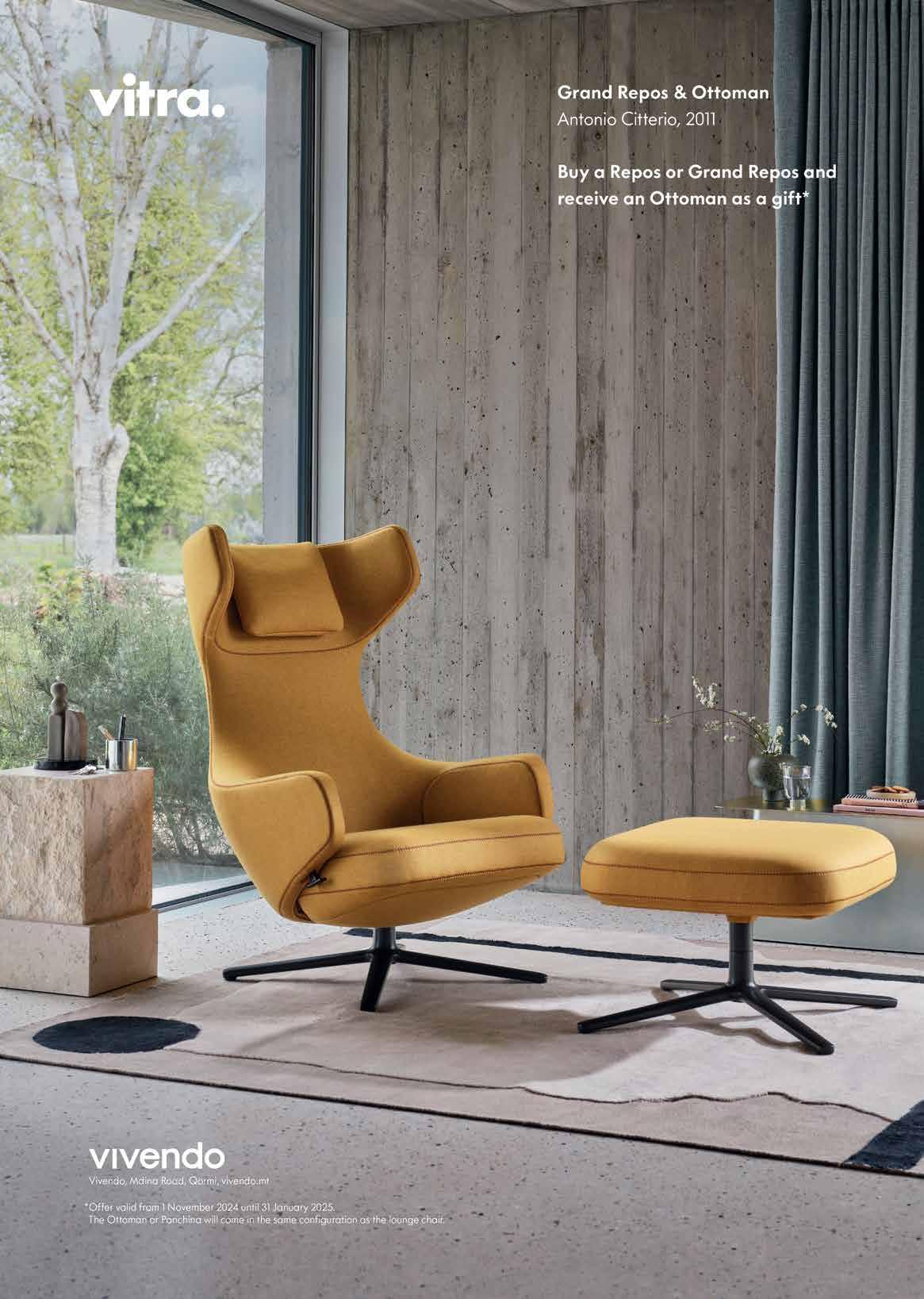
December 2024 - March 2025

MEIA emphasises that the budget once again falls short of establishing a comprehensive long-term vision for the creative sector, which should prioritise sustainability and address current instabilities and realities.
PAGE 13
The Malta Entertainment Industry and Arts Association (MEIA) responds to the 2025 budget

Malta celebrated excellence in architecture through an exclusive three-night event culminating in an official Awards Ceremony recognisng the most remarkable local architectural projects.
PAGE 15
Premju Emanuele Luigi Galizia Awards curated by an international jury

It honestly feels like a prayer, a mantra in action. I learn to observe my automatic fleeting thoughts and allow them to pass by – John Paul Azzopardi
PAGE 17
2B Gallery and Joanna Delia present The Beautiful Bones by John Paul Azzopardi
Contact info@artpaper.press
Website www.artpaper.press
Instagram artpaper.press
Facebook artpaper.press
Editor Lily Agius
Graphic Design
Nicholas Cutajar

Global perceptions of African art and artists are evolving beyond stereotypical notions of Africa as a place of wilderness and primeval traditions – at last.
PAGE 18
The third edition of the Accra Cultural Week 2024

The artist is nothing more than a filter that returns the zeitgeist of his time, but how can this be true if we do not allow ourselves the necessary slowness to experience the reality of our time?
PAGE 22
A Conversation with Nicola Martini, an artist as a researcher, teacher, and sculptor, who believes art is a bridge.
Writers + Contributors
Leonardo Caffo
Joanna Delia
Erica Giusta
Lisa Gwen
MEIA
Featured Artists and other
John Paul Azzopardi
Kamra tal-Periti
Lydia Cecil
Nicola Martin
Zvesdan Reljic
Paul Scerri
Joana Vasconcelos
Zvezdan was more than a photographer, printmaker or publisher. He was a catalyst; he brought people together through his initiatives and projects - it is no stretch to claim that he almost single-handedly shaped the landscape for B&W analogue photography on the island.
Museums + Galleries
2B Gallery
Christine X Art Gallery
Dikan Gallery, Ghana Gallery 1957, Ghana
Lily Agius Gallery
Malta Postal Museum & Arts Hub
MICAS
R Gallery
Spajzu Kreattiv

PAGE 26
Lisa Gwen remembers the work of the late Zvezdan Reljic READ
Supported by AX Roselli Hotel
2B Gallery
AP Valletta
Babel BAS
Chemimart
Christine X Gallery
Edwards Lowell
Festivals Malta
iLab Photo
Light Design Solutions
Manoel Theatre
Mercury
MICAS
MUZA Myoka
Niche Workspace No.43
People & Skin
R Gallery
Risette
Society of Arts
Soho Workspace
Teatru Manoel
The Malta Society of Arts
The Phoenicia Hotel
The Victor Pasmore
Gallery
Unbound Art Space
Valletta Contemporary
VeeGeeBee Art Supplies
Vivendo Projects
WANT YOUR WORK OR EXHIBITION FEATURED IN ARTPAPER?
Send us an email on info@artpaper.press titled FEATURED IN ARTPAPER with images and information!




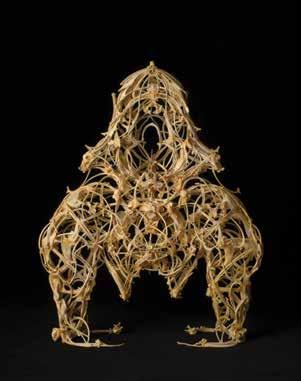



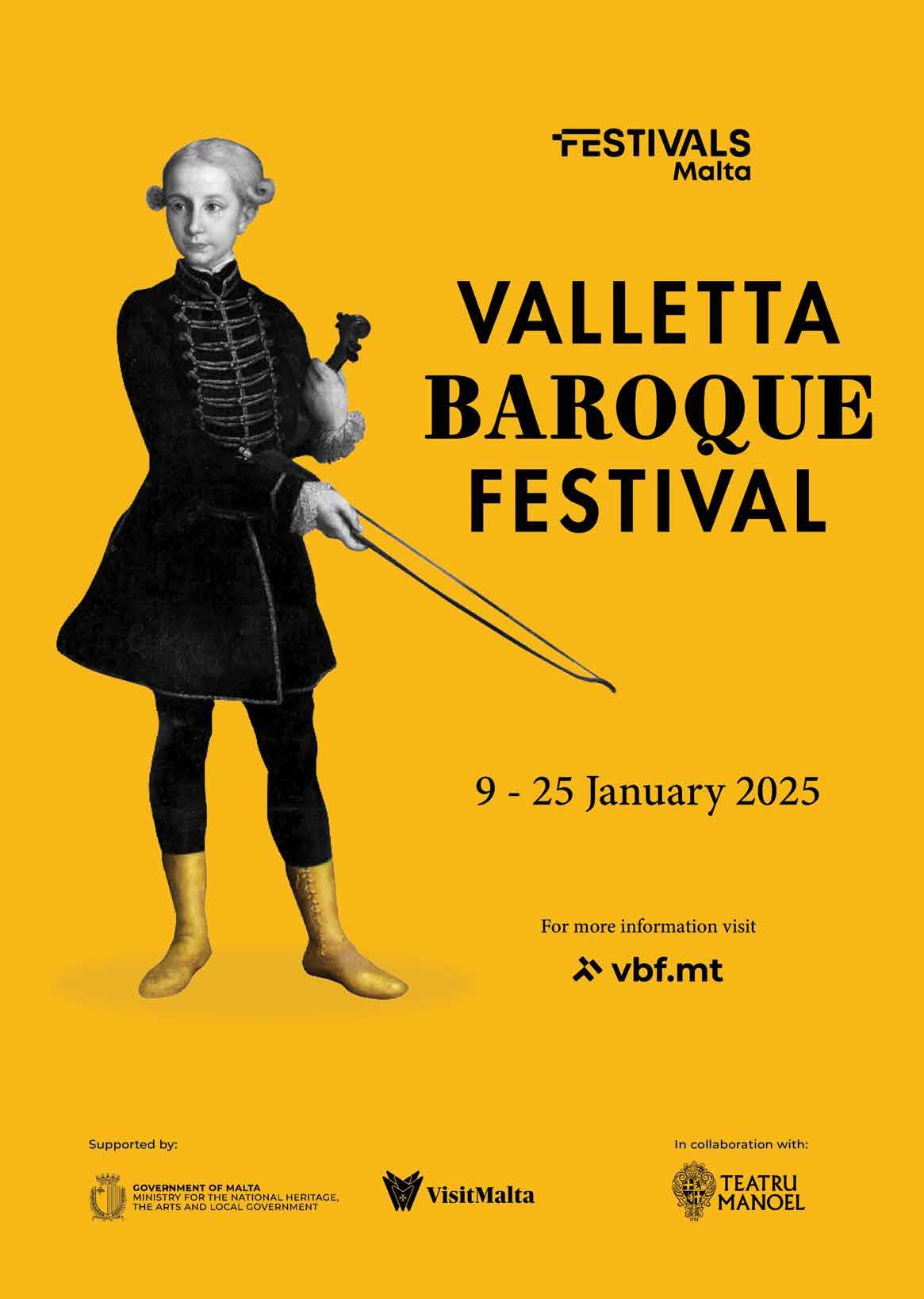

December 2024 - March 2025

The Sound of You Dreaming will bring together a collection of new works by Paul Scerri. It is curated by Gabriel Zammit with associate curator Andrew Borg Wirth. Held in Space C at Spazju Kreattiv this exhibition delves into dreams and asks the question ‘what does it mean to dream alone and together? Is it possible to hear the sound of you dreaming?’
It is a well known fact that our dreams follow archetypal patterns that cut across time and culture. Dreams are a rupture in the process of understanding the world because they contradict everyday notions of time and space, but at the same time they also contain strange and deep truths, both personal and collective. Paul Scerri works through these ideas in the collection he is developing for The Sound of You Dreaming. His stylised visual language poeticises the contradictions which guide the unfolding of human relationships, rendering them in an artistic language born from over 40 years of working with ceramic. His evocative and alchemical sculptures find parallels with the technique of dreaming, both in terms of form and content.
Friday 17 January to Sunday 9 March, Spazju Kreattiv.

Breitling inaugurated its first monobrand store in Malta
Breitling officially opened its first flagship boutique in Malta, located in the vibrant town of St. Julian’s, with a ribbon-cutting ceremony attended by the brand’s new Breitling Retail Director, Jacopo Caspani.
Breitling’s retail expansion continues with its entry into Malta. This follows recent openings in Rome, the Taormina boutique inaugurated last summer, as well as in Turin (2023) and Milan
(2022). The new store opened its doors last November in St. Julian’s, one of the island’s most dynamic cities.
The Breitling boutique, managed in partnership with the retailer Edwards Lowell, is located in the heart of the city within the newly completed Mercury Towers, part of St. Julian’s luxury complex designed by renowned architect Zaha Hadid.
www.breitling.com
he Malta Postal Museum and Arts Hub presented a series of talks titled Personal Perspectives III - The Greatest Painting in the World Ranging in style from a Book of Hours to contemporary art, speakers Lucy Paterson, Alex Manche, Maria Zammit, David Bartolo, Patricia Camilleri and Gabriel Zammit gave an insight into what they believe is the world’s greatest painting and what moves them in a very personal way.
Malta Postal Museum’s, 135, Archbishop Street, Valletta. For more information on the Malta Postal Museum’s upcoming events and exhibitions follow them on Instagram and visit www.maltapostalmuseum. com.
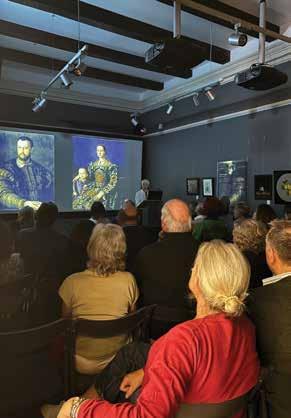

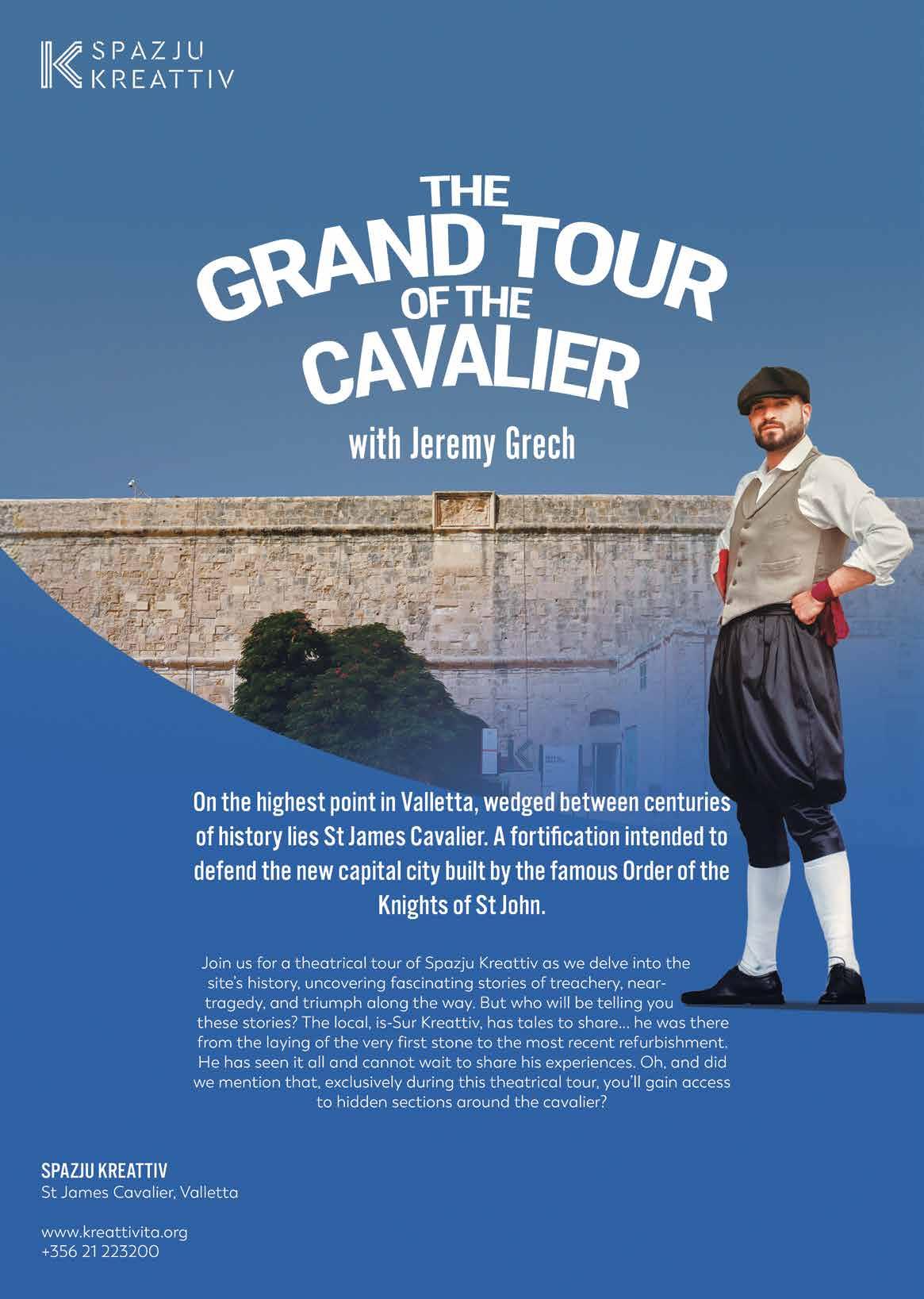
/ Exhibition & Festival

Aunique art exhibition featuring the talent of young students aged 6 to 14 under the guidance of art teacher Sue Gregory is being held at The Phoenicia Hotel in Floriana from 28 November to 1 December.
The exhibition showcases the favourite artwork of each young artist which they generously donated to be sold, with all proceeds going to support Dr Klown (Malta), an NGO dedicated to bringing joy to hospitalised children through the magic of clown therapy.
This exhibition has been made possible thanks to the initiative of Mrs Martina Bruno and is sponsored and supported by The Phoenicia Hotel and Gemelli Framing.
Festivals Malta presents the Valletta Baroque Festival from January 9 to January 25, 2025 with a programme celebrating a wide tapestry of early music. Under the artistic direction of Kenneth Zammit Tabona, this year’s festival will feature a stellar lineup of performances from distinguished artists and ensembles in some of Malta’s most opulent venues.

The festival will take place across various historic venues, including the magnificent St John’s Co-Cathedral, the intimate Lapsi Church, and the enchanting Verdala Palace. Each location provides a stunning backdrop, enhancing the listening experience and connecting audiences with Malta’s rich cultural heritage.
The Valletta Baroque Festival is organised by Festivals Malta in collaboration with Teatru Manoel, and supported by Visit Malta and the Ministry for National Heritage, the Arts & Local Government (Kultura).
For more information, visit www.vbf.mt


December 2024 - March 2025
alta’s first ever national contemporary arts museum – the Malta International Contemporary Arts Space (MICAS) – was inaugurated on Friday 25th October 2024 with a monumental exhibition from the acclaimed and visionary Portuguese artist Joana Vasconcelos.

MICAS was officially opened by Prime Minister Robert Abela together with Joana Vasconcelos, as well as Minister for National Heritage, Arts and Local Government Owen Bonnici, and the MICAS board, led by executive chairperson Phyllis Muscat. Special guests at the official inauguration cast their eyes on three major works of Joana Vasconcelos – Tree Of Life, Garden of Eden, and Valkyrie Mumbet – as well as a series of other works, which literally took over the four-storey space at MICAS.
Guests at the MICAS inauguration took their seats at the foot of Vasconcelos’s Solitaire – a creation which reproduces a diamond ring on a monumental scale, made up of 110 golden car rims and crowned by an inverted pyramid composed of 1,450 crystal whisky glasses. At the end of the speeches, the Prime Minister and Joana Vasconcelos later made their way through the MICAS esplanade and to the Galleries, where together with Phyllis Muscat, officially declared MICAS open to the public, with a fireworks display crowning off the official ceremony.
Other works exhibited at MICAS are The Garden of Eden, Loft, Vista Interior, Aspirin Sofa, Euro-Visão [Euro-Vision], Valletta, and Spin. Out on the MICAS esplanade, guests could also see some of the few acquisitions of MICAS, namely the Swiss artist Ugo Rondinone’s the radiant, and British artist Conrad Shawcross’s The Dappled Light of the Sun. Together with the soon-to-relocated Sea Cave (Entrance) by the Spanish artist Cristina Iglesias, these pieces will be permanently located at MICAS, where a sculpture garden is also set to be completed in 2025.
Since 2018, MICAS has hosted these artists for its annual International Art Weekends and Conversations series, as well as American artist Michele Oka Doner, whose loaned artwork The Palm Goddess for Malta is perched atop one of the plinths at the Teatru Rjal in Valletta; and French artist Pierre Huyghe.

The Malta Entertainment Industry and Arts Association (MEIA) responds to the 2025 budget, highlighting both concerns and positive developments.
MEIA continues to advocate for a strategic approach that addresses immediate needs while fostering longterm sustainability, which is still lacking in this budget. The association underscores the importance of a holistic integrated vision, emphasising collaboration among various stakeholders and ministries to achieve impactful progress.
MEIA emphasises that the budget once again falls short of establishing a comprehensive long-term vision for the creative sector, which should prioritise sustainability and address current instabilities and realities. A thriving creative economy requires more than just investment in temporary projects; it needs holistic support that addresses sector-specific professionalisation needs, affordable infrastructure, and integrated cultural education. Longterm growth should be prioritised through sustainable funding and financial mechanisms that reduce dependency on short-term grants. Sustainable practices, social security, and effective incentives that can provide stability, aligning the creative economy with broader economic and social growth goals.
Read their observations and opinions with the full press release online discussing the following:
• Public Sector vs. Private Sector
• Funding Increases – Creative Malta and Arts Council
• Accessibility to Creative Spaces

• Research and Tax Considerations
MEIA acknowledges the progress made in recent years, however, it is crucial to recognise the realities and daily challenges faced by industry professionals. Many creative professionals juggle multiple jobs to sustain their practices, while others struggle with limited access to production spaces and high costs, all within a competitive private-public sector environment. MEIA also values the ongoing discussions with various ministries and institutions, hoping that these dialogues will lead to actionable outcomes. Nonetheless, much work remains to achieve a more integrated approach that addresses the needs of Malta’s creative and entertainment sectors holistically and across ministries. A truly effective budget must understand the realities faced today while also recognising the missed opportunities.
Read the full article on: artpaper.press/news/2025-budgetresponse/



December 2024 - March 2025
MALTA
Here are the winners:
Malta celebrated excellence in architecture through an exclusive threenight event (from 23rd to 25th October) culminating in an official Awards Ceremony recognising the most remarkable local architectural projects.
SHARE Architects had the honor of being invited by the organisers, The Kamra tal-Periti (Chamber of Architects and Civil Engineers), to curate the international jury panel that selected the finalists and which has decided the winner of the prestigious Premju Emanuele Luigi Galizia.
In addition to the Grand Prize (Overall Award), the jury also awarded prizes in 7 core categories (design excellence, community impact, interior architecture, heritage preservation, landscape architecture, architecture vision, and innovation), two special categories (emerging practice and climate action), and two role model categories (architecture leadership and lifetime achievement).
Design Excellence Award:
Bothouse by SON Architecture
Landscape Architecture Award: The Rehabilitation and Restoration of Wied Fulija Landfills by DTR
Innovation Special Commendation: Aircraft MRO Hangar Facility by EM Architects
Community Impact Award: Dar Tereza by Local Office for Architecture
Interior Architecture Award:
Casa Ursula by Openworkstudio
Heritage Preservation Award: Casa Gourgion by MODEL Architects & CVC Architecture Studio
Architecture Vision Award: The Regenerative Multi-Modal Transport System by Mizzi Studio, and City of a 1000 Gardens by NIDUM
Architecture Vision Special Commendation for Sustainability: Help Malta Breathe by Periti Studio, and The Way We Live by Valentino
Architects
Emerging Practice Award: SON Architecture
Architecture Leadership Award: Mayor Paul Buttigieg


Lifetime Achievement Award: Perit David Felice
Special Contribution to the Profession Award: Mr Tony Cassar
President’s Award (the highest award of the night): City of a 1000 Gardens by NIDUM
Special commendations:
Interior Architecture Special Commendation 2024: Twentyfour
Architecture Vision Special Commendation 2024: The Way We Live
Architecture Vision Special Commendation 2024:
Help Malta Breathe Innovation Special Commendation 2024: Aircraft MRO Hangar Facility
The Jury featured five esteemed members of the #SHAREArchitectsSociety, who bring a wealth of experience and international perspectives to this prestigious architectural award:
Simonetta Cenci, Partner at Ateliers Alfonso Femia, Italy
Isabel van Haute, Founding Partner of Coldefy & Associés Architectes Urbanistes, France
Davide Macullo, Founder of Davide Macullo Architects, Switzerland
Thomas Coldefy, Founding Partners of Coldefy & Associés Architectes Urbanistes, France
Giuseppe Farris, Founder of Studio Farris, Belgium
https://kamratalperiti.org/premjuemanuele-luigi-galizia/

December 2024 - March 2025
MALTA
2B Gallery and Joanna Delia are proud to present John Paul Azzopardi’s highly anticipated solo exhibition - his first one in 5 years in fact. Opening on Sunday 15 December, this landmark event marks the first time Azzopardi will exhibit his evocative bone sculptures as a collection, offering audiences a rare opportunity to engage with his most profound works to date.
An Artist of Philosophical Depth: John Paul Azzopardi’s career spans nearly two decades, marked by exhibitions that explore the intricate relationship between transience and permanence, life and death.
Known for his participation in the 2017 Venice Biennale (Homo Melitensis: An Incomplete Inventory in 19 Chapters), with works featured in esteemed collections such as MUŻA (The National Museum of Fine Arts, Malta), Azzopardi’s sculptures are both visually captivating and intellectually provocative.
“I have been creating these bones works for several years, and one of the main reasons is that as an artistic practice it serves as meditation, a practice that makes me slow down physically and mentally, requiring me to be extremely patient with every action during the construction of the work.” Says John Paul.
“Every bone that is glued to another requires me to be very still and patient until the bones are bonded, but not only that, since during the first stages the structures are extremely delicate and the sculpture can easily fall apart, so even my movements have to be soft and slow. The structure starts to strengthen when it starts to become more and more 3 dimensional, because all sides start to support each other. It then becomes solid once the artwork is then covered in resin. Although I start with a basic out line in mind the internal patterns are not planned but simply unfold during the process.”
Crafted from bone and imbued with existential themes, his works invite viewers to confront the specter
of mortality while celebrating the resilience of life.
“I try not to have my mind lean to much on other thoughts but automatically the mind wonders at times. Since as mentioned the process of creation is extremely delicate, I feel that my attention and movement have to be akin to a surgeon. The work hopefully portrays the stillness and attention I give each and every one of the sculptures. This is one of the reasons I still create these works. But I also create them to allow its stillness, silence and its fragility to serve as a feedback loop to the observer, hoping that the person can resonate with the work or that the work itself serves as an instrument to allow the observe’s mind to quieten down. I believe certain forms of beauty do generate this form of feeling. The bones as a reminder to temporarily allow your judgemental mind to die, and become just mere presence. If the work doesn’t make you feel that way then at least it can serve as a reminder to experience it in other moments during that day.
When I am cleaning the bones on many occasions I am constantly reminded that we / our bodies / our time in the world is little more than nothing; a memento mori that can give us an opportunity to embrace life. The cleaning part, is not only messy and smelly, but can at times be very sad. It honestly feels like a prayer, a mantra in action. I learn to observe my automatic fleeting thoughts and allow them to pass by, quickly acknowledging that they are there, only to then let them fade whilst simultaneously keeping my eye on the work.
I spend long hours every day working on these sculptures because I believe in discipline. When one work is done I usually know what I’ll be doing next, but there are periods when im not productive or decide to work with a completely different medium/subject etc. And yes, I do enjoy looking at my works, but not only to enjoy their beauty but also to analyse them… to hopefully discover how to improve the smoothness of the patterns and outlines.”
John Paul’s Notable Exhibitions
This solo exhibition continues a
remarkable trajectory that includes notable solo exhibitions such as Silver River (2019, Lily Agius Gallery, Malta), What One Sees Is What One Is (2016, National Museum of Natural History, Mdina), and Curved Silence (2011, National Museum of Fine Arts, Valletta). Azzopardi’s collective exhibition history is equally impressive, with recent highlights including But I See Beauty and Wonder (2024, Spazju Kreattiv, Malta) and Liquid Key (2024, The Splendid, Valletta).
A Special Moment at 2B Gallery
This exhibition is a pivotal moment for 2B Gallery, celebrating not only Azzopardi’s return to the solo spotlight but also the culmination of his unique approach to art. By presenting his first-ever complete collection of bone sculptures, John Paul Azzopardi showcases the depth of his craftsmanship and his ability to articulate universal truths through intricate, haunting forms.
Joanna Delia’s Visionary Collaboration
This exhibition highlights Joanna Delia’s unwavering dedication to supporting local artists and bringing their work to the forefront of the global art stage. By partnering with 2B Gallery, Joanna continues to champion innovative talents like John Paul Azzopardi, creating a platform for boundarypushing art that challenges and inspires. This collaboration embodies a shared mission to celebrate artists and ensure
their stories and creative expressions reach audiences far and wide.
About John Paul Azzopardi
John Paul Azzopardi is a Maltese artist renowned for his deeply philosophical approach to art and his intricate bone sculptures. Through his work, Azzopardi explores profound themes of existence, decay, and the interplay between life and death. With a career spanning nearly two decades, including participation in the Venice Biennale and exhibitions across Malta and beyond, his art continues to provoke thought and evoke emotion on a profound level.
About 2B Gallery
Situated in the vibrant district of St. Julians, 2B Gallery is Malta’s premier destination for contemporary art. Known for its commitment to showcasing cutting-edge and thought-provoking works, the gallery serves as a platform for both established and emerging artists to share their unique visions with local and international audiences.
Opening Sunday, 15 December 2024, 4 -11pm, at 2B Gallery, 1 Forest Street, St Julian’s. RSVP: www.2B.mt/rsvp
If you are interested to attend the exclusive collectors preview event before the official opening, contact the Commercial Art Advisor, Michelle, to secure your invitation, limited to 24 guests.

News / Accra Cultural Week / Ghana
December 2024 - March 2025
ERICA GIUSTA
Invited by the Omeena Art Foundation, a not-for-profit dedicated to supporting and promoting Ghanaian art across continents, Erica Giusta reports from the Accra Cultural Week 2024.
Earlier this fall, at the end of October, most art galleries based in the Ghanaian capital were more animated than usual, teeming with swarms of art enthusiasts, journalists, artists, curators and collectors, thanks to the third edition of Cultural Week. An initiative of Accrabased Gallery 1957, this five-days-long programme of talks, exhibitions and visits to heritage sites brought together a diverse audience ranging from emerging local talents to internationally acclaimed professionals, solidifying the growing reputation of the country as key player on the global art scene.
In recent years, Ghanaian artist such as Amoako Boafo, El Anatsui, Serge Attukwei Clottey, Gideon Appah and Ibrahim Mahama have been celebrated and invited to exhibit in prestigious art institutions world-wide. This has contributed to raise awareness on contemporary West African art in established European and American circuits and, most importantly, it has generated opportunities in the country itself. Most of these artists, who remain firmly and intentionally based in Ghana, are in fact leveraging their success on the international art market to create new spaces for expressions and exchange within local communities, while providing practical solutions for environmental and social regeneration too while doing so. A great example in this respect is the work and the creative process adopted by Serge Attukwei Clottey: in his studio in Labadi, he transforms plastic waste into striking polychrome artefacts, involving the local community at all stages. Men and women living in the neighborhood contribute to the collection, cleaning and manipulation of disused gallons and other plastic materials, which get cut into thousands of small squares like mosaic tiles, and eventually reconfigured as part of large site-specific installations,

Global perceptions of African art and artists are evolving beyond stereotypical notions of Africa as a place of wilderness and primeval traditions – at last.
which Serge Attukwei Clottey describes as “an exploration of the meanings that are invested in quotidian objects and how such materials circulate in local and global economies”.
In a similar way, the direct impact that contemporary art and artistic education can have on communities is at the core of Dikan, a gallery and a cultural centre including the biggest library on photography in the region. The founder and main curator Paul Ninson describes the mission of this multifaceted project as an effort to provide a valid local alternative to overseas education, mostly in the U.S.A. or the U.K., which usually comes at a high cost not only from a financial perspective but from a personal and a cultural one as well. A photographer himself, Paul Ninson brings the continent’s visual history back home to start a new, original narrative, enabling African talents to take the lead in doing so. Presenting ‘Tewahedo: The Ancient Faith of Ethiopian Orthodox Christians’ by photographers Sehin Tewabe and Svenja Krueger, the gallery positions itself as one of the most promising emerging platforms within the Cultural Week circuit, and, most importantly, on the contemporary photography international scene.
dot.atelier, founded by Ghanaian artist Kwesi Botchway, provides equally relevant insights on the local creative ecosystem. Inaugurated in December 2022 as a non-commercial space fostering collaboration and exploration, the space hosts a number of residencies attracting the attention and support of both the neighboring Labadi and Osu communities and of the international creative community at large. The architectural qualities of the building itself, hosting bright and spacious studios, an exhibition space and a library, all connected by a beautifully crafted exterior staircase in rammed earth, certainly contribute to making
dot.atelier one of the most inspiring art spaces in town.
As reported by various international publications, the number of galleries and art spaces in the country has been consistently rising in the past few years. The Accra Cultural Week and the success of Gallery 1957 more in general, have been fundamental pillars in the growth of this new cultural infrastructure.
Launched by Marwan Zakhem in 2016 on Ghanaian Independence Day, Gallery 1957 has since expanded across three gallery spaces in Accra and one in London. Originally set up to promote Ghana’s presence in the arts scene, it now encompasses the Global South and its diaspora, collaborating with
its most prominent voices, such as writer and curator Ekow Eshun. The grand opening of the group exhibition ‘Keeping Time’, which Eshun curated in collaboration with Karon Hepburn in the main space of Gallery 1957, was the highlight of the week and a celebration of notions of Blackness, being, and time, questioning Western perceptions of modernity and progress. Artists
Lois Selasie Arde-Acquah and Andrew Pierre Hart, with solo shows which also inaugurated during Cultural Week in the other two spaces of the Gallery in Accra, mesmerized the audience with explorations of ‘mundane mindfulness’ and questions of ‘what it means to listen and to hear’, respectively.



A few days after Accra Cultural Week, most of its crowd regrouped in Lagos, where international contemporary art fair Art X inaugurated its 9th edition. In spite of recent economic difficulties and the socio-political turmoil that they stirred, the Nigerian event attracted significant international interest, indicating how global perceptions of African art and artists are evolving beyond stereotypical notions of Africa as a place of wilderness and primeval traditions – at last!
In this globalised world, making space for contemporary African art on established European and American platforms is as imperative and overdue as it is understanding that same art in its place of origin. Everybody should be given the opportunity to experience an installation by Serge Attukwei Clottey, for instance, in New York or Venice, but that will never compare to seeing it and witnessing the making of it in the artist’s studio at the core of Accra. Mark your calendar for Cultural Week 2025.

Exhibition /Malta / Interview - Lydia Cecil

RISETTE RESTAURANT EXHIBITS WORKS BY LONDON-BASED ARTIST LYDIA CECIL
Lydia Cecil is a representational artist who works between the UK and Malta. Cecil studied at the London Atelier of Representational Art and has exhibited across the UK, in Malta, Florence and Samoa. She currently works as a tutor for Raw Umber Studios and College Arts, and is represented by Cicek Gallery in London.
Cecil’s work is based on studies from life. She delves into the character of a portrait sitter, arranges contemporary still lives, and uses the alternating backdrops of the UK and Malta for her figurative work. These works capture ordinary, unscripted moments with an originality away from idealisation or objectification.
Unlike the room of the famous E.M. Forster book with its sun-soaked Italian inferences, this room is set in a house near the Dorset coast in southern England. Charming in a dilapidated way, the eaves slope from the single window whose light doesn’t quite penetrate to the back. The old wooden furniture has seen better days, and the fireplace
feels forgotten. Dusty books and mirrors speak of old status, while taped up paper drawings, of young eccentricity. Even while the wall paint cracks, its colour shifts under the light sources – from a cool, hazy blue from the soft British sun to a deeper, warm green under the artificial lamps. Standing amid the six large paintings, the room encases you. A single figure inhabits each canvas. Around the room, there are glances between them, into the mirrors, to the viewer. Each of the female-strong cast subtlety subverts the norm of how women are portrayed in traditional art. The only male is nude.
Slight shifts in perception can reveal our deep-rooted assumptions. The flies in our eyes. Or planks for those of you who prefer the Bible to Catch-22. After all, isn’t a dove a white pigeon?
Q&A WITH THE ARTIST, LYDIA CECIL
Can you discuss your personal style of painting and which artists and themes inspire you?
My personal style of painting is continuingly developing but is based on
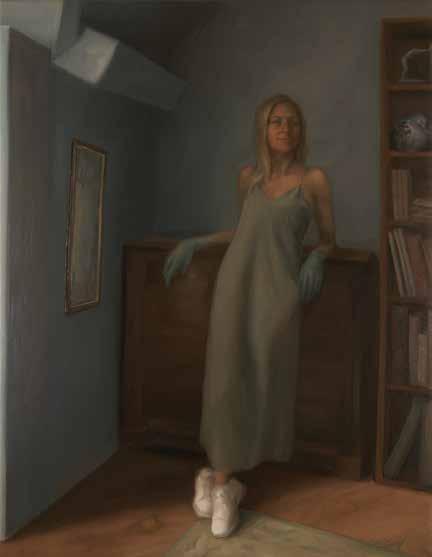
my training as a representational artist and study of early twentieth century artists. The ones that have particularly influenced my style over the years (non exclusive) would be Philip de László, Anders Zorn, Cecilia Beaux, Berthe Morisot, Giulia Lama, and those who influence both my style and choice of subject include Olga Boznanska (who’s name appears on one of the book spines in ‘A Room with a View’), Artemesia Gentileschi, Kathe Kollwitz, Laura Knight and Elizabeth Butler. And Sebastian Tanti Burlò, who always reminds me to expand my artistic style outside the academic.
How do you go about deciding the composition and themes of each painting?
My themes tend to emerge as the paintings do. In general, I lean towards the depiction of women and reintroducing elements of the natural world back alongside (natural) people. But I don’t like ‘explaining’ themes or paintings. Whatever people think or feel when they see them is valid. To execute the paintings, there’s a fair amount of sketching and colour studies to work out composition and balance of values
and colours. I constantly rearranged the room until I was happy. I used a variety of models and spent a long time photographing pigeons, who sadly don’t stay still long enough for me to paint. The paintings themselves each take about a month.
For the last few years I have been spending a lot of time in Malta, and found an exciting artistic community and many who enthusiastically appreciate and talk about art. Matthew at Risette is a perfect example of this, and I’m very grateful to him for this collaboration with Risette.”
A Room with a View is on display at Casa Ellul, 81 Old Theatre Street, Valletta, until May 2025. www. lydiacecil.co.uk

December 2024 - March 2025
LEONARDO CAFFO

Nicola Martini is a complex artist as a researcher, teacher, and sculptor. For years, in Italy, he has been trying to bring unconventional philosophical reflections to art with metaphysics, alternatives to ordinary life, and often anti-market logics that have nevertheless brought him significant fortune. With him, we inaugurate a series of important interviews with art professionals, curators, and artists, to reflect on the contradictions and resources of the contemporary art world at three hundred and sixty degrees.
As an artist, you have worked with Kaufmann Repetto and now you are represented by Clima gallery in Milan. How would you describe the art world, the world in which you operate between museums and fairs? How can you combine research needs, even highly philosophical and not immediately translatable into market logics, with the work you do? I remember very well a conversation we had about the metaphor of the Xenolith, the stranger. A fragment of rock carried by the rising magma during a volcanic eruption, included in the magmatic basalt, which maintains its characteristics even once the magma solidifies, preserving its state of alterity. I still believe that it remains an excellent example of how one can operate in today’s art system: disseminating here and there other, very hard matter, but at the same time allowing oneself to be enveloped by the warm magma of the problematic nature of a sector that shows the shadow of its own cultural and economic collapse.



“The artist is nothing more than a filter that returns the zeitgeist of his time, but how can this be true if we do not allow ourselves the necessary slowness to experience the reality of our time?”
You work on materials, but above all on their philosophy. Recently, you have also intertwined the Mediterranean, and together we worked on Mount Etna. What is the correlation between the metaphysical work you do in art and the transformations of the social world around us?
As you know, I believe that art is a bridge that can allow us to connect two or more conceptual and cultural shores. Even from the most recent scientific discoveries regarding the definition of consciousness as an extended entity in matter, we are trying to verify how certain quantum episodes manifest themselves in the same measure and form within our (and not only) brain as in the depths of space; we are witnessing a continuous “in and out” of ourselves that should make us reflect on how fragile the limits we set for ourselves are, only porous and permeable surfaces. Finally we are finding it in the materialistic realm of not organic life, what before was considered as a human prerogative.. this “mute” life is now taking voice, or rather we have understood that it makes perfect sense to try to tune in with what is around us.
I try to bring this model of permeability to a discipline that should be the one where everything is allowed, and which instead is often the most rigid of all: art.
My work is a hybrid golem made of extra-linguistic paradoxes that feeds on all the ambiguity of our social world; often our reality seems to us to be composed of too heterogeneous worlds to be understood. We begin to think of rejoining them all, embracing paradoxes and complexity.
How do you consider the current productive logic, social media, the art world so compressed in a “woke” culture, and the possibility that art will become truly useful again for social struggles as it was in the 1970s?
Unfortunately, they are all tools that operate against everything I have said so far. I believe that the greatest illusion of social media, at least for the profiles of art operators, is temporal. During the experience we have scrolling, a kind of accessory time is created that slows us down and at the same time build in us the fear of being left out of a flow, from the system, from the image of a perpetual success, a toxic mechanism. But it’s just an image, after all. It is often said that the artist is nothing more than a filter that returns the zeitgeist of his time, but how can this be true if we do not allow ourselves the necessary slowness to experience the reality of our time? With what courage do we express an opinion on a social fact if we don’t remember the smell of our studio, of the dog looking at us intently while we are lost commenting on the post of an exhibition that we will never visit? We must take that time back, turning it to the construction of that golem made of kins, otherwise we will end up isolating ourselves completely. The paradox of certain cultures that you mention is that they are the image of the failure in which we live. Trying to free ourselves from prejudice, we create new ghettos, new disparities, new abuses. It’s as if we forget every day that the logic you’re talking about constantly asks us to fill voids, with works and actions that have the daily duration of an anaesthetic that’s never enough. I was recently talking with a colleague and friend of mine about

“Let’s slow down, let’s gather together, we know perfectly well that artistic production has never been so empty, we have the opportunity to interrupt this mechanism, or at least sabotage it.”
how we no longer gather as much as the generation you’re referring to, we lack a collective identity. So I would start from here: an assembly in 2024 can be a revolutionary act.
As a teacher and researcher, you are also trying, with the obvious difficulties of the case, to work to undermine the idea that art must produce immediately, in an art fair logic, but to try to give space back to pure and applied research. Is it really possible?
Teaching in my practice is a glitch, a further step towards the poetics of the outsider we were talking about before. I believe that the most honest way to carry out this profession, which has prophetic traits, is to speak primarily to oneself, showing the students all those weaknesses and problems of a research dedicated solely to production for commercial purposes, in total imbalance. The moments at the Academy are (and can be) that “staying in the fold” of the system by expanding the moment of pure research; responding concretely to your question, I believe it is possible and necessary to explore with the students this need. I form my theoretical courses as laboratories, where we try to dismantle and reassemble everything. It is a form of resistance and some of them are attracted by it, they follow you.
You recently won the Fondazione Henraux Prize 2024, creating two sculptures. Can you tell us about them?
Both works are titled Omag Tower 7 CNC. Omag Tower 7 CNC is a robot. It weighs 1145 Kg and its body extends in space for about 3 metres, articulated on 6 axes. It can be programmed to perform different functions and different tools can be attached to its body: at the Henraux company it is used mainly for milling and removing stone material, both that extracted from the nearby Apuan Alps and that detached from distant mountains, scattered in other areas of the planet. This machine is used in the construction of the work to perforate, with hundreds of coring, an amorphous quarry shape, a rock found in a special slope made up


of immense “quarry waste”. The perforation of the said stone stopped one hole before its collapse.
Here too we reason about the creation of a bridge, a link between the critical issues of the extractive sector and the abuse of nature, and our internal composition, the calcium carbonate that makes up our bones and forms the marble that we see and sell. An invitation to make the boundaries of our usual perception of the materialistic universe that includes us more subtle and permeable.
Art seems bent on rather contradictory logics: on the one hand, closed in a moralism, where everything gives way to political correctness, on the other hand connected to super-immoral productive logics: wrong financing, tight production logics. Then, Trump wins and the art world understands that its bubble is not the real one. What to do?
I’m not sure the system has reached the level of awareness of the unreality of its own bubble, or rather it seems to me to see that behind the smiles of art dealers during art fairs, this shift you’re talking about, but it’s like if it’s hidden behind that anaesthetic of the recursive productivity perceived as normality. I believe that the initial step must come primarily from the artists, let’s slow down, let’s gather together, we know perfectly well that artistic production has never been so empty, we have the opportunity to interrupt this mechanism, or at least sabotage it.
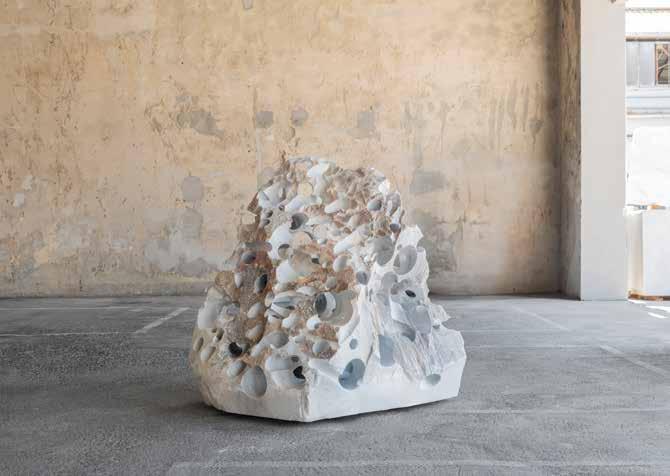
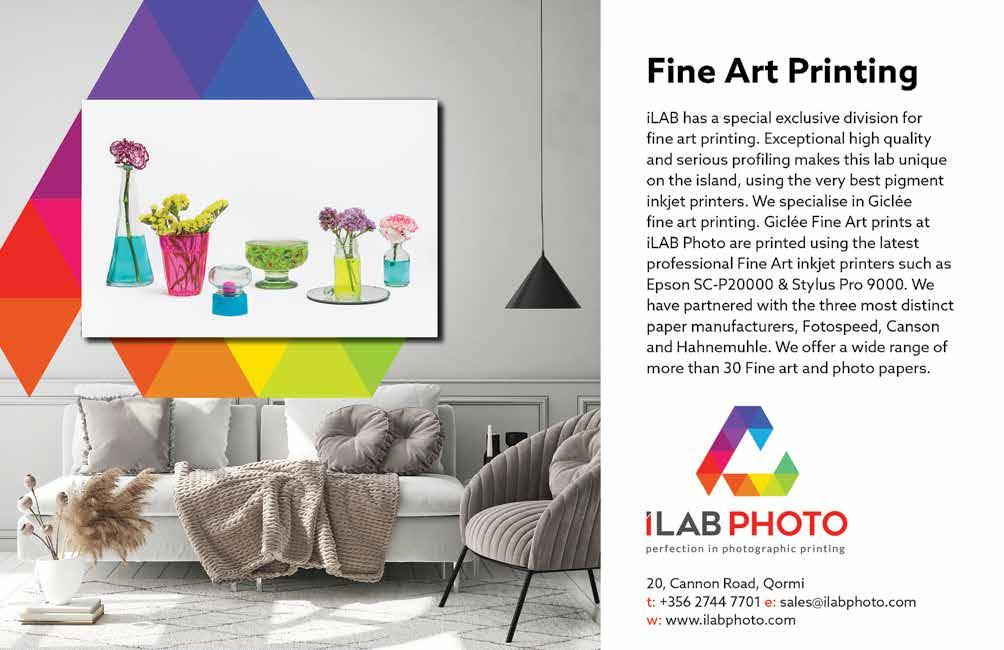

the
Ja, Ja, Ja!
LISA GWEN holds a first degree in History of Art and a Masters in Cultural Heritage Management. She is a freelance curator and writer for art and design events.


Absolutely confounded. It was a profuse struggle to attempt to make heads or tails of the exhibition text at R Gallery introducing Zvezdan Reljic’s solo show and collection of work, playfully titled: Ja, Ja, Ja! (June - August 2023). After going through it two or three times, I was simply none the wiser. Convoluted paragraphs, references ad nauseam, and hell of a lot of up-your-own-arsery…you didn’t need to understand it, really; just love it.
A caption below the ‘curatorial text’, proved revelatory: Written by ‘Dr’ GPT:
Confoundedness explained. This had Zvezdan’s seal of approval written all over it. Not only was it fitting, but it was perfectly in sync with his unique sense of humour. I can’t help but smile at the recollection; and I can’t help but recall his raucous, resounding laughter, either. His ‘style’ and his humour had been perfectly mirrored in the jabberwocky penned by the online medic.
Walking through R Gallery, almost 18 months ago, I was incredulous. Not at Zvez’s bravura - anyone who’s ever come within inches of him, knows he oozed all sorts of creative juices - quasi gratuitously - but rather, because we had
all been waiting for that show, for so long. Possibly from the moment directly after meeting him, and understanding all that was encapsulated in one human being. He’s had myriad projects - participating, collaborating, showing his work in collectives. Yet a proper solo exhibition remained elusive, somehow. * Or not, actually, because he was, perhaps, the most humble and supportive person on the Maltese art scene whom I had, and have still encountered, so far. There was no pretence, no expectation. Just a sharing of concepts, stories, narratives; as well as food, coffee, music and tobacco. Zvezdan even shared his home with all those who needed a location for
a shoot, a makeshift studio or simply a safe space in which to create and be their audacious selves - an audacity which he forever welcomed and encouraged.
Zvez had been living in Malta for some three decades. Which is why it is ironically painful and bittersweet that his first proper solo show took place in a mere months before his passing. A show which revealed both a sophisticated and increasingly playful evolution of style in his photography. An evolution which married darkroom analogue photography with graphic design and publishing.
December 2024 - March 2025

work oscillated continuously between traditional representation, sophisticated abstraction, and at times, also pure minimalism. And it is in the latter stances, that I found and experienced pure magic.
Imagine this: A ‘V’ and a line. Almost sounds like I’m describing a Miro painting of a girl and a bird. Yet, in this case, what is represented, is a shaven female crotch and the gentle divide between her thighs. It’s oh so subtle. Not in the least bit erotic, yet plenty cheeky, and truly masterful. Awkward angles, zoomed-in details, ‘aerial’ shots, distortion of perspective, and plenty of plays with light and shade, texture and positive / negative space. He possessed an uncanny ability to hone into detail and nuance, to frame a limb or a ‘body crease’, often resulting in an abstract, ‘obscure’ composition - the uncertainty of the portrayal at play, forever mesmerising and magnetically attractive.
Zvezdan was more than a photographer, printmaker or publisher. He was a catalyst; he brought people together through his initiatives and projects - it is no stretch to claim that he almost single-handedly shaped the landscape for B&W analogue photography on the island; many of those possessing and using a vintage camera, having done so, after indubitably contracting the photography bug, from his apartment in Sliema, where he held courses in darkroom printing and photography. He transmitted his love of photography to many of those he met, often extending his workshop / masterclass skills, and professional consultation, far beyond the designated hours. In fact, there is immensely talented cluster of young emerging photographers, whose aesthetic betrays the master to whom they are indebted.
Zvezdan was the epitome of prolific: he worked on his photography, whilst
The thought of the magnitude of his oeuvre, the sheer volume of work he produced and collaborated on, the variety of projects he spearheaded or facilitated… and the possibilities locked in the ‘what ifs’, produces a distinct twitching of the innards, which can only be explained through loss and grief.
Zvezdan’s website and social media pages are a panoply of nudes and portraits. The subject(s) of his work, as much a staple as the grainy, pointillist texture of his photographs, or of his creamy / chocolatey chromatic choices. His website, says nothing about him, yet
it contains all you need to know about his aesthetic, through plentiful visuals which reflect the context in which he lived and worked, the many interesting humans that crossed his life, and his positively unique worldview. There’s no bio, no never-ending CV of projects: Prints. Contact. Workshop. That’s all he wanted to show. The weight of importance equally distributed between the work of the self, and how it can inform and be imparted unto the other.
Expanses of skin: The subtitle describes his oeuvre of work, as much as the content and subject matter represented. Zvezdan was a profoundly figurative artist, yet his





simultaneously running his publishing house, EDE books, as well as founding, running and managing Kixott cooperative, not to mention the many projects and collaborations hovering in the background. He had a quiet strength and a fierce demeanour. He made things happen. Constantly, consistently. There was always something brewing - much like his coffee; a staple of his, as much as his cigs - and there was always some visionary project in the pipeline. He unknowingly and inadvertently created a most significant legacy, through the sheer love and passion infused in all he did.
Much has been written about Zvezdan since December 22, 2023. I guess, I purposely
chose to ‘ignore’ the history and the context and focus on his creative output. He was the kind of person who impressed you at every encounter. His eyes saw things which an average human eye would be envious of, even with sensitive training. Perhaps that was how he charmed us allby giving us a glimpse of what he saw, and the opportunity of witnessing it with our own set of eyes.
* Zvezdan Reljic also had a solo exhibition at the Malta Postal Hub in 2017, as part of the project titled ‘Somna’, in collaboration with three dancers / performers.


